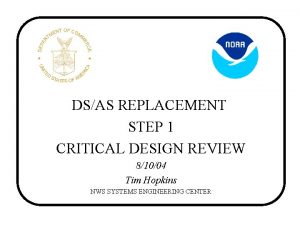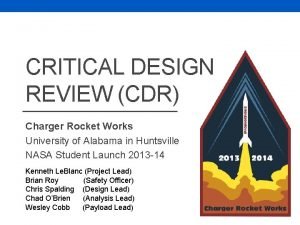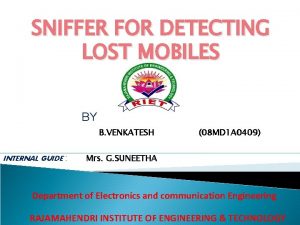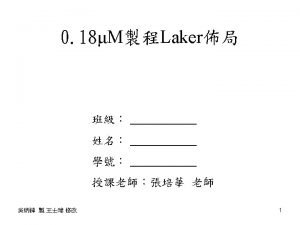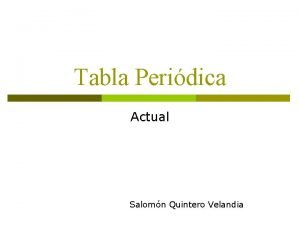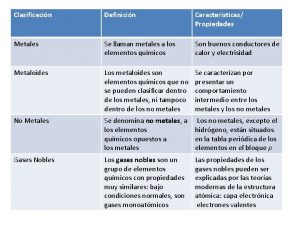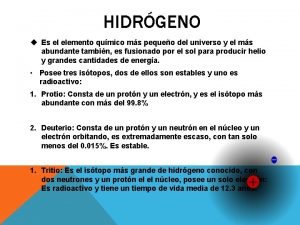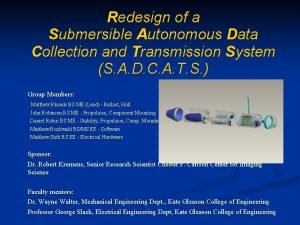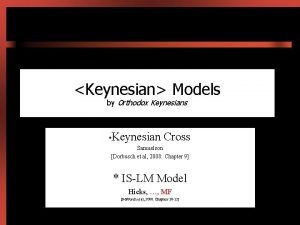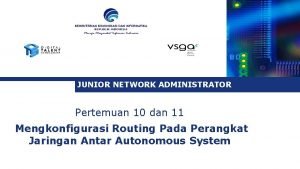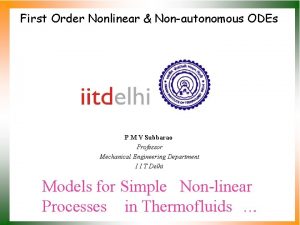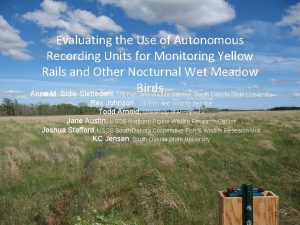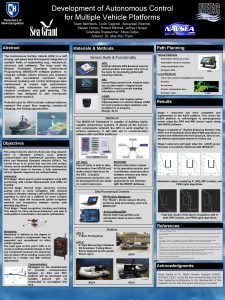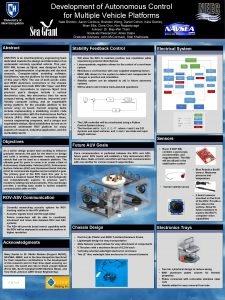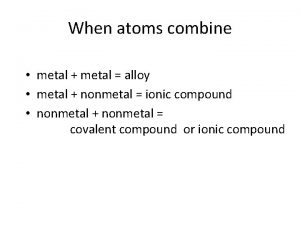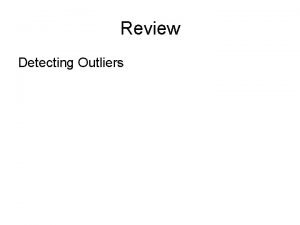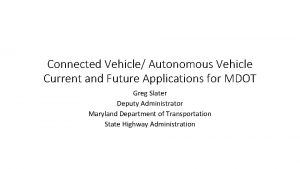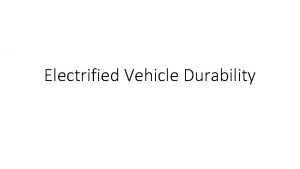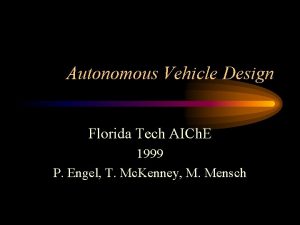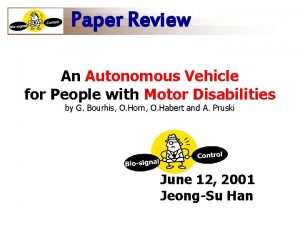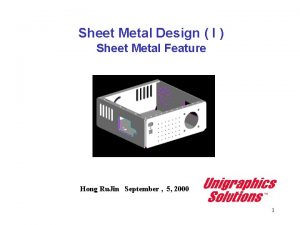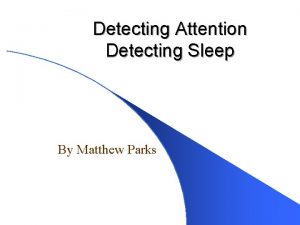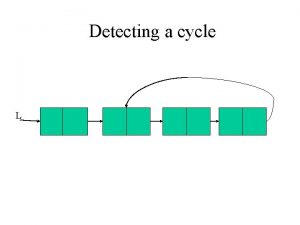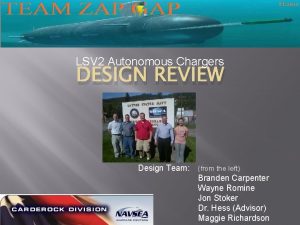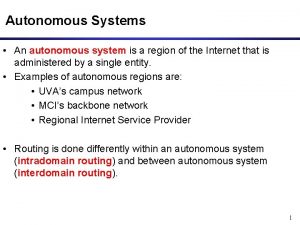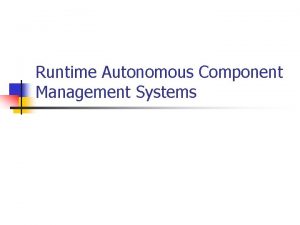AMDV Autonomous Metal Detecting Vehicle Critical Design Review













































![Functions • • • public static void main(String[] args) Starts new instance of GUI Functions • • • public static void main(String[] args) Starts new instance of GUI](https://slidetodoc.com/presentation_image_h/c8ed1260f50dd0ff294de193deb24c90/image-46.jpg)







- Slides: 53

AMDV: Autonomous Metal Detecting Vehicle Critical Design Review Bob Augustine Christopher Bond Mike Grasso

Project Overview • • To design, build, and test a robotic vehicle to locate and mark the location of metallic objects. The project idea targets both recreational and official use although the primary goals and objectives of this preliminary design and prototype will mainly target the recreational audience. Recreational use of this device would be by treasure hunter enthusiast to find lost metallic objects which may or may not be buried in the ground without having to manually search the area themselves. Future design revisions may be targeted more towards the official use of the device by law enforcement and military personnel to locate possible hazardous metallic objects.

Goals and Objectives • • • The AMDV will be low cost, easy to use, and have a light weight, portable design The AMDV must be able to perform outside in good weather conditions ie-The AMDV does not have to be weatherproofed The AMDV will go through the following recursive pattern once initiated until the user turns it off: The vehicle shall move autonomously or manually in areas outdoors or indoors w This mode shall be determined by user input wirelessly via a computer w When operating autonomously, the vehicle will use a pre-programmed search pattern while performing obstacle avoidance and detecting metallic objects. w While operating manually, the vehicle shall communicate to the aforementioned computer for movement and other commands The vehicle shall sense when it has gone over metal, stop, log the location, and notify the user it has found a metallic object via a feedback mechanism Upon User-Input, the AMDV will continue operation under the previous operational mode

Requirements and Specifications • • • The AMDV must run for a continuous 15 minutes The AMDV must be able to detect metal within a depth of 5 inches The AMDV must have a method of recording at least 20 waypoints (locations) The AMDV GPS must be accurate to within 5 meters The AMDV must detect obstructions at a minimum of 12 inches

Block Diagram: Project Breakdown GPS (Bob) Microcontrollers (Chris) Bluetooth (Chris/Bob) AMDV Computer Software (Bob) Metal Detector (Mike) R/C Car: Motors, Steering (Mike/Chris) Sensors (Bob) Power Center (Mike) Software/GUI (Bob)

Hardware

Sensor: Requirements • • Sensor Purpose: Used for collision avoidance The sensor must be able to meet the following specifications: - Works outside - Works at a wide range of distances w Minimal Distance: at least 6 inches w Maximum Distance: at least 1 meter - Operate at 5 V - Well documented

Sensor: Options PARALLAX PING))) Ultrasonic Maxbotix LV-EZ 1 Ultrasonic Sharp GP 2 Y 0 A 21 YK IR Yes Limited 5 +- 10% 2. 5 – 5. 5 4. 5 – 5. 5 Min Detection Distance 2 cm 6 in 10 cm Max Detection Distance 3 m 254 in 80 cm Vdd, Vss, 1 I/O pin $29. 99 RS 232, Analog, PWM $24. 95 Vo, Vcc, GND (JST) $9. 95 Technology Can use in sunlight? Supply Voltage Connections Cost

Sensor: LV-EZ 1 • • • Choose Maxbotix LV-EZ 1 Can be used in sunlight Can be powered by 3. 3 V or 5 V Good detection range Analog Communication Relatively low cost Connected to analog input pins on MCU Cost: $0. 00 Donated by manufacture

GPS: Requirements • • GPS Purpose: Used to mark location of metallic objects found The GPS must be able to meet the following specifications: Fast satellite fix time Small, inclusive chipset – GPS module and engine board Well documented Support WAAS High Accuracy (less than 5 meters)

GPS: Options EM-406 a EM-408 ET-112 Si. RF Star. III/LP Single Media. Tek MT 3318 20 20 12 5 Meters (WAAS) Cold Start / Hot Start Acquisition Time(sec) 42 / 8 48 / 8 Data Communication TTL TTL External Antenna No Yes $46. 99 $47. 99 $43. 99 Chipset Number of Channels Accuracy Cost

GPS: EM-406 a • • • Choose EM-406 a Good reviews and support Operating Voltage of 4. 5 -6. 5 V TTL Communication Relatively low cost Connected to digital pins on MCU Cost: $37. 59 Discounted by manufacture

Detection Types • • • Very low frequency (VLF) – Receiver coil – Transmitter coil Pulse induction (PI) – Short power burst – Usually a one coil system Beat-frequency oscillation (BFO) – Search coil – Reference Coil

BFO • • A change in the oscillation creates a voltage through the output. When both oscillators are the same, it reaches ‘zero beat’ in which there is 0 voltage outputted

Metal Detector Design

Metal Detection Design • • CS 209 A - Made by cherry semiconductors - Has a better detection range - No longer in production TDA 0161 - Made by ST Microelectronics - Readily available

TDA 0161

TDA 0161 Implementation

TDA 0161 Implementation

TDA 0161 Schematic

Metal Detection Status • • Metal detection works - Range up to 3’’ Sensitivity could be improved - Higher range detection Still implemented as a subsystem - Needs to be integrated with the microcontroller Needs to be tested outside the lab

H-Bridge • • • Two Designs Built using transistors - 4 transistors Built implementing ICs - SN 754410 1 A Motor Driver - More compact - Easier to use

H-Bridge SN 754410

H-Bridge Issues • • Overheated the original H-Bridge Built the H-Bridge using Transistors - Overheated - Mostly likely due to hooking it directly to the 9 V battery

Power Supply • • • 9 V main power supply Regulated with variable voltage regulators - LM 317 T The RC car used a 6 V power supply The microcontroller will use 5 V Metal Detector will use 9 V

R/C Car: Requirements • The Vehicle must be able to meet the following specifications: - Cost below $60 - Large frame size to maximize PCB working room - Off-road frame type

R/C Car: Hummer H 2 • • Already on hand - $0 to implement Off-Road Frame

Wireless Module: Requirements • The Wireless Module must be able to meet the following specifications: - Cost under $100 - Communicate without being in the line of sight - Communicate from at least 20 feet away - House an integrated antenna - Operating voltage of 5 V

Wireless Technology: Options XBee Ranges/Power Consumption Max. Permitted Approx. Power (m. W) Range (M) Range (ft) 900 10, 000 31, 360 50 1, 500 5, 280 2 120 400 1 100 300 Class 1 2 3 Max. Permitted Power (m. W) 100 2. 5 1 Bluetooth Classes Approx. Range (M) 100 10 1 Efficiency (M/m. W) 11 30 60 100 Approx. Range (ft) 328. 1 32. 8 3. 3 Efficiency (M/m. W) 1 4 1 Bluetooth and XBee/Zig. Bee Comparison Wireless Technology XBee/Zig. Bee Bluetooth Focus Application Monitoring and Control Device Connectivity Battery Life Bandwidth Years Estimated 250 Kbps 100+ Meters 720 Kbps or 2 -3 Mbps 10 -100 Meters 1 Week Estimated Typical Range Advantages Low Power, Range Convenience

Bluetooth Module: Options Chip Name Modem Module Name SMD Module Cost DIP with RP-SMA Antennae Price Modem Module Cost SMD Dimensions DIP Dimensions Modem Dimension (mm) Antenna Power Consumption Operating Voltage Modem Operating Voltage Interface Purchase web site Class Range Frequency Operating Temperature Roving Networks RN-41 Blue. SMi. RF Gold/RP-SMA Modem $34. 95 $59. 95 Unavailable $64. 95 ~25. 4 x 22. 9 mm 51. 5 x 15. 8 x 5. 6 mm Compact Ceramic (integrated) or RP-SMA (modem only) 25 m. A average 3. 3 V-6 V UART Spark. Fun Class 1 up to 350 ft (106 m) 2. 4~2. 524 GHz -40°C + 70°C NXP/Philips BGB 203 Blue. SMi. RF Silver Modem $29. 95 $54. 95 $59. 95 $49. 95 ~22 x 5. 6 mm 51. 5 x 15. 8 x 5. 6 mm Compact Ceramic (integrated) or RP-SMA (module only) 25 m. A average 3. 3 V-6 V UART Spark. Fun Class 2 up to 100 ft (30 m) 2. 4~2. 524 GHz -40°C + 70°C Bluegiga WT 11 -A-HCI Unavailable $29. 33 Unavailable 35. 3 x 14 x 2. 3 mm Unavailable Compact Ceramic (integrated) or U. FL connector 30 m. A max 3. 2 V-3. 4 V Unavailable UART Semiconductor. Store. com Class 1 up to 328 ft (100 m) 2. 4~2. 524 GHz -40°C +85°C Bluetooth Version Support Data Throughput 2. 1/2. 0+EDR/1. 2/1. 1 2 -3 Mpbs 1. 2 721 Kbps 2. 0+EDR Compliant, 2. 1 Ready 2 -3 Mpbs

Wireless Module: Bluetooth - Blue. SMi. RF Gold • • • $64. 95 from Sparkfun Electronics 5 V operating voltage Simple pinout – 6 pins BT technology doesn’t require lineof-sight BT Class 1 Device – Range up to 350 ft Integrated compact ceramic antenna

Remote Controller: Requirements • The RC must be able to meet the following specifications: - Cost less than $100 to acquire - Can turn the vehicle left/right - Accelerate the vehicle forward/backward - Put the vehicle in either automatic or manual control mode using a button - Contain feedback device for metal detector component

Remote Controller: Options Connectivity Buttons Battery Type/Life Cost Units In Hand Wii Remote PS 3 Dualshock 3 Controller Bluetooth 10 analog buttons + 2 digital buttons 6 digital buttons + 8 -way directional pad direction pad + 2 analog sticks MSI Wind U 100 Laptop Bluetooth/XBee via dongle Included RC Remote 104+ 2 2 -way sticks 4 Hrs Est. Included with RC Vehicle 10 hrs 39. 99 10 hrs 42. 99 4 Hrs 379. 95 4 0 1 RF

Remote Controller: MSI Wind Netbook • • Already on hand - $0 to implement Can program and control the AMDV via built-in Bluetooth 10 -inch LCD screen 4 hour battery life

Microcontroller (MCU): Requirements • The MCU and its development board must meet the following specifications: - Cost under $100, including development board - Use a familiar programming language, like C/C++ - Have lots of online free documentation and examples - Sufficient amounts of memory, I/O ports, and processing power - Operating voltage of 5 V - MCU must be small, within 10 cm x 10 cm - Low power consumption

MCU: Options Company Price CPU Architecture Flash Memory EEPROM Memory RAM I/O Lines Temperature Range Operating Voltage Power Consumption - Active Power Consumption - Standby Power Consumption - Off (RAM Retention) Theoretical Max Power Consumption Performance Package Dimensions MSP 430 F 2013 IN Texas Instruments $1. 90 16 -bit RISC 2 KB 256 B 128 B 10 -40°C to 85°C 2. 2 V - 3. 6 V 220µA @ 1 Mhz, 2. 2 V Atmega 328 Atmel $5. 50 8 -bit RISC 32 KB 512 B 1 KB 23 -40°C to 85°C 1. 8 V -5. 5 V 300µA @ 1 Mhz, 1. 8 V 0. 5µA @ 1 Mhz, 2. 2 V 0. 8µA @ 1 Mhz, 1. 8 V 0. 1µA @ 1 Mhz, 2. 2 V 0. 1 @ 1 Mhz, 1. 8 V 7. 7 m. W 10. 8 m. W Up to 16 MIPS @ 16 MHz 14 pin PDIP 19. 69(L) x 6. 6(W) mm Up to 20 MIPS @ 20 MHz 28 pin DIP 37. 5(L) x 9. 5(W) mm

MCU Development Board: Options e. Z 430 -F 2013 Arduino Duemilanove MCU TI MSP 430 Atmel ATmega 328 Cost $20. 00 $29. 95 RS 232/USB USB USB/DC Power Supply ~65(L) x 20(W) mm 68. 6(L) x 53. 3(W) mm ti-estore. com Spark. Fun PC Connection Power Dimensions Site

MCU: Atmel ATmega 328 • • Cheap: $5. 50 each (for a total of $11. 00 for two) from Sparkfun Electronics Arduino Bootloader Allows use of same C/C++ code from development board 28 pin DIP package 8 -bit RISC @ 16 MHz 32 KB of program space 23 I/O Lines 5 V Operating Voltage

MCU Development Board: Arduino Duemilanove • • • Cheap: $29. 95 from Sparkfun Electronics USB for power and data Open Source - C/C++ Compiler - Lots of easily accessible tutorials & examples w w http: //www. arduino. cc/ http: //www. sparkfun. c om/commerce/tutorial s. php

Block Diagram: Top Level Hardware View

Electrical Schematic

Software

GUI • • Used to send and receive information to and from the AMDV via a COMM port on the computer Event Driven - User mouse and button clicks - Incoming communications from the AMDV Programmed in Java - Version: JDK 1. 6. 0_13 IDE: Eclipse 3. 4. 1

Current GUI (V 1. 3)

Libraries Standard Libraries: • • Used to create and use the GUI - java. awt. *; javax. swing. *; java. awt. event. *; javax. swing. border. Titled. Border; javax. swing. plaf. basic. Basic. Arrow. Butt on; Used for system date and time - java. text. Date. Format; java. text. Simple. Date. Format; java. util. Date; Used for data storage - java. util. Vector; Used for serial I/O - javax. comm. *; java. io. IOException; java. io. Input. Stream; java. io. Output. Stream; Non Standard Libraries: • Javax. comm. *; - Used for communication with computer ports in java Originally created by Sun Microsystems but no longer supported. Sun recommends a 3 rd party library called Rx/Tx. w w Rx/Tx didn’t work correctly all the time Original release still works, so using it
![Functions public static void mainString args Starts new instance of GUI Functions • • • public static void main(String[] args) Starts new instance of GUI](https://slidetodoc.com/presentation_image_h/c8ed1260f50dd0ff294de193deb24c90/image-46.jpg)
Functions • • • public static void main(String[] args) Starts new instance of GUI public static void run(JApplet applet, int width, int height) Creates the applet public void init() Creates the GUI interface public void start() GUI’s actual running function Currently empty because GUI is event based public void action. Performed(Action. Event button. Pressed) Called when the auto/manual mode button is pressed Processes which button was pressed public void mouse. Pressed(Mouse. Event button. Pressed) Called when mouse is pressed on directional pad Processes which button was pressed • • • public void mouse. Released(Mouse. Event button. Pressed) Called when mouse is released Processes which button was released on directional pad Required functions but not used: public void mouse. Clicked(Mouse. Event e) public void mouse. Entered(Mouse. Event e) public void mouse. Exited(Mouse. Event e) public String current. Time() Gets the current system time public void update. Run. Log(String message) Updates the run log public void update. GPSLog(String message) Updates the GPS log

Functions (continued) • • public void prep. Command(Abstract. Button button) Processes and prepares the command to send to AMDV public void deactivate. Manual. Buttons() Deactivates the manual control buttons public void activate. Manual. Buttons() Activates the manual control buttons public void port. Selection() Prompts user for communication port public void port. Not. Selected() Bad port selection public void connect ( String port. Name ) Connects to the AMDV over the chosen port public boolean send. Command(int command. ID) Sends the command across the chosen port (data to AMDV) public void serial. Event(Serial. Port. Event arg 0) Reads the communication ports (data from AMDV)

Microcontroller Software • • Used to communicate between and control two onboard microcontrollers. Used to send and receive information to and from the AMDV via a serial Bluetooth connection to a computer. Programmed in a subset of C IDE: Arduino alpha V 0015

Microcontroller Software • • Currently software is being developed as needed to test hardware components These test beds will serve as a basis for the final software design

Administrative Aspects

Cost Breakdown As of 6/14/09 Part Estimated Cost Real Cost R/C Car (Motors, Frame, Motor Control) $45. 00 $7. 85 (Already Had Frame and Motors) Metal Detector (Full metal dection circuit) $15. 00 $10. 24 Bluetooth Communication (Computer + AMDV hardware) $464. 95 $64. 95 (Already had computer Bluetooth) Microcontroller (Development + final hardware) $40. 95 $9. 00 $13. 72 GPS $46. 99 $37. 59 Sensor $24. 95 $0. 00 Shipping and Tax $30. 00 $37. 23 $676. 84 $212. 53 Power Center (Batteries + connections) Total Costs:

Progress Overview Percent Complete

Questions?
 Critical semi critical and non critical instruments
Critical semi critical and non critical instruments Spaulding classification of medical devices ppt
Spaulding classification of medical devices ppt![Private string[] Private string[]](data:image/svg+xml,%3Csvg%20xmlns=%22http://www.w3.org/2000/svg%22%20viewBox=%220%200%20200%20200%22%3E%3C/svg%3E) Private string[]
Private string[] Critical design review
Critical design review Critical design review
Critical design review Critical design review
Critical design review Cdr design review
Cdr design review Critical design review
Critical design review Cdr critical design review
Cdr critical design review Sniffer for detecting lost mobiles
Sniffer for detecting lost mobiles Detecting evolutionary forces in language change
Detecting evolutionary forces in language change Event 4672
Event 4672 How do fraud symptoms help in detecting fraud
How do fraud symptoms help in detecting fraud Havex
Havex Venn diagram of solid liquid gas
Venn diagram of solid liquid gas Metals and non metals
Metals and non metals Dp periodic table
Dp periodic table Difference between metal oxides and non metal oxides
Difference between metal oxides and non metal oxides Nwell
Nwell Metals are used
Metals are used Periodic table pure substances
Periodic table pure substances Ionic compounds have
Ionic compounds have Grupo b tabla periódica
Grupo b tabla periódica Metal and non metal definition
Metal and non metal definition Símbolo químico del hidrógeno
Símbolo químico del hidrógeno Reactivity periodic table
Reactivity periodic table Existen tres isotopos naturales del potasio 39k 40k y 41k
Existen tres isotopos naturales del potasio 39k 40k y 41k Compare non-critical readers with critical readers.
Compare non-critical readers with critical readers. Ucl critical review
Ucl critical review Literature map template creswell
Literature map template creswell Critical review example
Critical review example Statistik inferensial menurut para ahli
Statistik inferensial menurut para ahli Associative stage
Associative stage Autonomous benthic explorer
Autonomous benthic explorer Autonomous work teams
Autonomous work teams Autonomous data harvesting
Autonomous data harvesting Atonic vs autonomous bladder
Atonic vs autonomous bladder Atonic vs autonomous bladder
Atonic vs autonomous bladder Autonomous expenditure formula
Autonomous expenditure formula Autonomous system adalah
Autonomous system adalah Autonomous spending
Autonomous spending Oh happy dy
Oh happy dy Autonomous ode definition
Autonomous ode definition Autonomous recording units
Autonomous recording units Autonomous consumption
Autonomous consumption Relative income hypothesis
Relative income hypothesis Algebric demand function
Algebric demand function Lwapp to autonomous
Lwapp to autonomous Autonomous investment
Autonomous investment Autonomous differential equation
Autonomous differential equation Equilibrium output
Equilibrium output Autonomous vs induced expenditure
Autonomous vs induced expenditure Autonomous expenditure
Autonomous expenditure Choque medular
Choque medular


![Private string[] Private string[]](https://slidetodoc.com/wp-content/uploads/2020/11/2462436_9160c29323cf5e5f63079258a42a9977-300x225.jpg)
